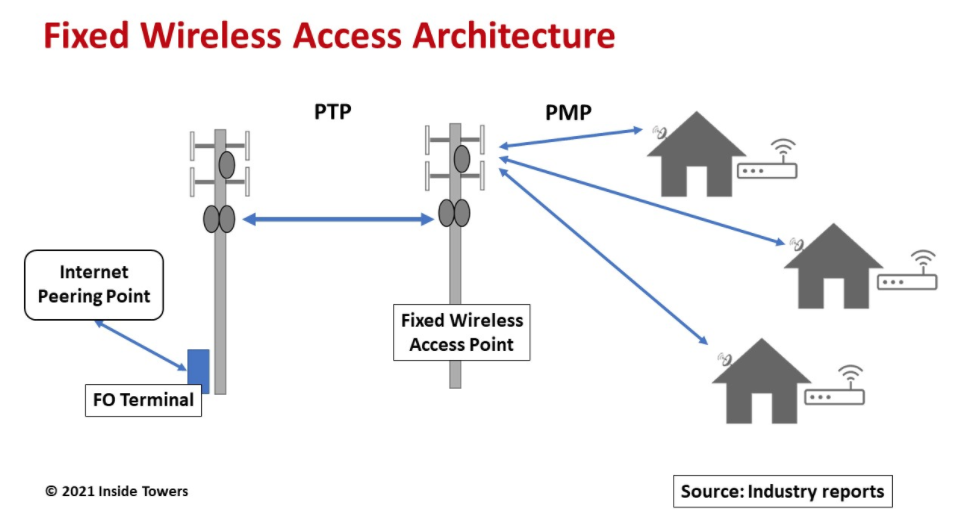Fixed wireless access technology gets a bad rap. Critics list FWA shortcomings: low data throughput, limited serving area, needs line of sight transmission, not as secure as fiber, will never match fiber performance.
Such criticism may be true but that is not the point. FWA will meet or exceed FCC-defined minimum broadband speeds (currently, 25 Mbps download/3 Mbps upload) in many applications, especially where fiber or copper broadband services do not extend beyond established residential and commercial boundaries.
Moreover, FWA can deliver internet access to underserved and unserved areas of the country in shorter time frames and more economically than fiber on a per subscriber basis.
FWA architecture comprises an access point, essentially a radio base station, on a tower, rooftop, water tower or other structure overlooking the serving area. The radio system is operating in a point-to-multipoint configuration connecting to homes or businesses in that serving area.
Each subscriber location has customer premise equipment with an external antenna to connect over the air to the access point. CPE connects over Ethernet to a WiFi router that then distributes internet connections to wireless devices inside the premises.
Access points usually connect directly to the nearest internet peering point via a fiber optic link. If fiber is not available at that site, subscriber connections can be backhauled over a point-to-point microwave hop to another site with a fiber connection. Here’s where the arguments arise.
Achieving high-speed internet connections with FWA depends on the operating frequency. FWA can utilize various bands with different propagation characteristics. Generally, the lower the frequency, the longer the distance but often at reduced throughput.
For instance, the UHF (470-698 MHz) TV White Spaces frequencies, such as those used for Microsoft’s Airband project, help close the digital divide because these signals can travel long distances over non line-of-sight paths in rural areas. Some TVWS deployments can achieve up to 15 Mbps download speeds up to 10 miles.
Unlicensed frequencies such as 5.4 and 5.8 GHz are a mainstay for many wireless internet service providers in PMP applications. Base stations can aggregate 20 MHz channels in these frequencies up to 1 Gbps of throughput to be shared among subscribers served by an access point. Base stations and CPE using unlicensed frequencies are relatively inexpensive and easy to install.
King Street Wireless, partnering with UScellular (NYSE: USM), offers targeted FWA in 27 states covering nearly 8 million people using an average of 12 MHz of 700 MHz 4G LTE licensed spectrum that it owns. With excellent coverage, especially in the midwest, KSW can deliver broadband-level download speeds over a mile.
Wide swaths of mid-band spectrum up to 40 MHz in 3.5 GHz CBRS and up to 200 MHz in 3.7 GHz C-band seem to offer the best balance between throughput and distance. At these mid-band frequencies, delivering up to 1 Gbps to subscribers over 1-2 km is doable.
Verizon (NYSE: VZ) was the big license winner in the FCC CBRS and C-band auctions. Expect VZ to deploy these bands for both 5G New Radio in mobility and fixed applications nationwide. Other C-band auction winners including AT&T (NYSE: T), T-Mobile (NASDAQ: TMUS) and USM likely will follow suit.
Using millimeter wave spectrum for FWA is often touted as the holy grail for high-speed, low latency internet connections. With hundreds of MHz of bandwidth at 24, 28 and 39 GHz, throughput is excellent for connections up to 1 Gbps but only over short distances, often measured in hundreds of feet. Carriers can extend 5G FWA mmW small cell reach using repeaters. (see, Maximizing 5G mmW Coverage with Repeaters).
The FCC’s Rural Development Opportunity Fund will underwrite wireline and wireless service providers’ broadband deployments in two tranches up to $16 billion over 10 years to help close the digital divide.
It is interesting to note that of the top 10 RDOF auction winners, six bidders included FWA as a technology option to fiber, cable, xDSL, and satellite proposals. Of those, the three big rural local exchange carriers – CenturyLink, Windstream, and Frontier – bid $1.2 billion. Windstream and Frontier included FWA to augment their established wireline fiber and xDSL footprints. CenturyLink opted for a fiber-only approach.
Delivering broadband connections to homes and businesses that lack them is especially important.
Provisioning broadband, however, is not a zero-sum game where one technology wins while others lose. The fact of the matter is that no one technology fits all and the telecommunications industry needs all of them.
The tradeoffs come in service delivery, time to market, and deployment and operating costs. By that measure, FWA holds its own in those long-reach, low-density applications for which it is best suited.
By John Celentano, Inside Towers Business Editor





Reader Interactions